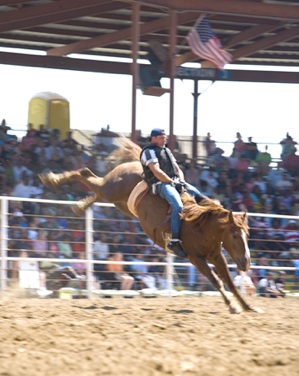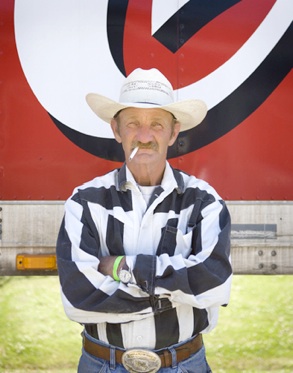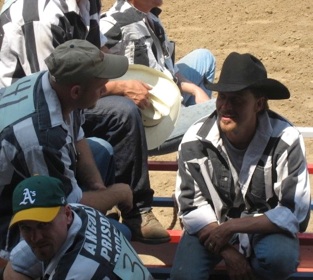2:00 p.m.
The inmates know that if they were to act up and mess up and cause something to happen during the rodeo, then I wouldn’t have the rodeo. And so, therefore, there’s tremendous peer pressure to bring out the best behavior in everyone. And we don’t have any incidences. We won’t have any problems today. No one will try to leave, and everything’s gonna be peaches. We’re gonna have a good rodeo, and you’ll see the inmates be very well behaved. It’s a safe prison. It’s as safe here as any street in New Orleans. Now, y’all ready to go have a rodeo?
Warden Burl Cain (xli)
The April 21, 2007 rodeo begins with a performance by the “Glory Riders,” the only horseback-mounted Christian Ministry in the United States. According to the group’s website, the Glory Riders “ride under the banner of Jesus Christ” (xlii). The self-proclaimed purpose of the group is to “share the love of God, His saving grace and mercy in the western tradition.” The Glory Riders only add to a unique performance steeped in patriotism and religion, and enhance the appearance of an event designed upon the premise of morality, rehabilitation, and redemption. Often the phase of redressive action “involves a ‘sacrifice’ literal or moral” (xliii). The Glory Riders are part of the moral element necessary in the redressive phase of the social drama, the performance of the Glory Riders introduces the possibility of repair. The religious undercurrent guiding the event reflects the effort to portray a wholesome and moral image to the public. The righteous presentation also serves to prepare the audience for what comes next—the public sacrifice that must occur: Watch.
After a few of the introductions standard to a sporting event— acknowledgement of sponsors, the presentation of flags and the singing of the National Anthem—a stadium procession involving rodeo participants ends with warden Cain riding into the stadium in a chariot. The warden, a latter-day Caesar has entered the Coliseum. Two survey respondents equated this event, especially the opening ceremony, with an ancient ritual procession. When asked what he liked about his visit to the rodeo and crafts fair one visitor responded, “I was captivated when I walked into the arena … I also got the feeling that I was watching Caesar’s gladiator games, with Burl Cain playing Caesar and the inmates playing gladiators.” It was this same “gladiator aesthetic” that caused another visitor to question if she would return next year; she was also one of the few tourists I spoke with who leveled a critique of the experience. She tells me,
I realize that these people are there for a reason, but it doesn’t mean we need to use their pain as a spectator sport. This was like the Gladiator days when people were put in the arena with wild animals for the pleasure of the spectators. I think this should not be a tourist attraction at all. There was nothing attractive about it.
After circling the ring and being showered by the applause of the audience, the warden ascends to his perch atop the stadium and addresses the crowd. Cain’s husky voice welcomes the audience and encourages them to “cheer the bravery of the inmates” as they “do battle in the ring.” The warden’s slow and deliberate drawl flows over the public address system of the stadium. The warden welcomes the spectator into the redressive phase of the social drama. The rodeo reintroduces public forms of punishment and invites the non-incarcerated citizen to serve as a witness of the power of the state. This event is a newly envisioned public spectacle and the rodeo arena becomes a modern variation of the public scaffold.
During the rodeo the audience witnesses a few men succeed, but most often watches them fail and suffer painful punishment. The audience cheers both the success and failure of the competitor; both entertain them. The audience is absolved of feeling sympathy for the inmates not only because they have committed crimes, but also because the punishment is couched in a language of sport and entertainment. Despite the warden’s rhetoric of rehabilitation, a sub-plot of ridicule underwrites the rodeo’s script. Throughout the rodeo, the “inmate cowboys” are presented as inept objects deserving of punishment. According to the Prison Rodeo Program for the October 2006 event, the unskilled inmate makes for “hilarious entertainment” where even the animals “mock the frustrated riders.” Of course, even this humiliation is presented in a “rhetoric of redemption.” Throughout the event the announcer cites the competitors’ ability to “triumph” over adversity and “conquer” the competition.
At the prison rodeo, many traditional rodeo activities such as bareback horse riding, bull riding, calf roping, and barrel racing occur. The prison rodeo competition typically consists of ten events, a number of which have been designed especially for this spectacle. The names of some events imply a certain connection to the public fantasy of incarceration. Tourists view, “Bust Out,” “Down and Dirty,” and “Buddy Pick Up.” Each of these events reflects an image of barbaric, desperate, and sexualized incarcerated bodies put on display for a viewing audience. Anthropologist Melissa Schrift also found that the rodeo performance serves as “a forum for … the public’s fascination with criminality” and that the event is set against a backdrop of “deeply ingrained racial and sexual codes, violence, and state authoritarianism” (xliv). For example, “Buddy Pick Up” depicts a timeless escape fantasy, complete with a competitor in the role of the heroic leading man on horseback and a damsel in distress (played by another competitor). The romantic nature of the event is undeniable. First, the audience laughs as the two men attempt the escape, but as they successfully ride away together the stadium fills with cheers: Watch.
Visitors bear witness to the brutality of the rodeo on the bodies of the untrained participants, which for some is justifiable because it serves as punishment for the inmate’s crime. Like the scaffold, the rodeo physically disciplines inmates in the presence of a public acting as judge and jury. Tourists are invited to witness the violence in the ring as punishment for crime. “My mom feels bad about how rough the bull ride was for one of the prisoners,” a tourist tells me as we are leaving the event. She and her mother have always lived in Louisiana; she had attended the event once before, but at seventy-five this was her mother’s first visit. She continues, “my mother has a really soft heart for most people, but I reminded her that these prisoners had stole, sold drugs, raped, beaten and murdered people in order to get to prison.” At this point I hear the voice of another tourist, “these are the worst of the worst in Louisiana.” The voice of authority—the warden, the state, and the media—comes flowing out of the mouths of visitors as they police the boundaries of the experience. Not only is this visitor attempting to justify the prison system as a means to punish violent transgressors, she provides a rationale for the rodeo as a dangerous, yet cathartic event. Like the public executions of 17th century Europe, masses of spectators participate in the collective act of public discipline during the rodeo. The rodeo depicts a classic representation of the prison system where the violent offender in need of punishment is publicly beaten and subdued under the supervision of a stern, yet loving warden/father figure, all to the cheers of an adoring, and approving crowd.






